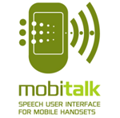Projects
Indicative list of R&D projects with the participation of members of the Speech Synthesis Group
Long Lasting Memories (ICT PSP) |
|
 |
LLM (Long Lasting Memories) aims to develop and test a unified ICT platform which will combine state-of-the-art cognitive exercises with physical activity in the framework of an advanced ambient assisted living environment. By combining cognitive exercises and physical activity LLM will deliver an effective countermeasure against age-related cognitive decline, thus actively improving the quality of life of the elderly. The LLM service can be installed in individual homes, day care centres, or more formal medical settings, enabling the accident-free, personalized and monitored physical and cognitive training of its users. |
MobiTalk - Speech user interface for mobile devices (National Funding) |
|
 |
MOBITALK aims at the integration of speech technologies into mobile networks and devices. Coordinated research and development efforts towards this aim included the creation of new and, the improvement of, existing speech synthesis algorithms and practices, the implementation and setup of new applications in mobile phones, the development of applications for the short messaging centres of mobile networks as well as research in user requirements and the commercial exploitation of project results. |
Transfer and Adaptation of Text-to-Speech Technology to the Bulgarian Language (INTERREG III / PHARE CBC) |
|
 |
The aim of the project is to transfer text-to-speech (TtS) technology and to adapt it to the Bulgarian language for developing a speech synthesis engine for Bulgarian. An important by-product will be the collection and processing of Bulgarian corpora (text and spoken corpora). An additional goal of the project will be to exploit the TtS engine for speech-enhancing a cultural web portal that will be developed, making it more accessible to visually impaired people. |
HEARTS - Home-based Everyday activities Analysis and Response Telecare System (National Funding) |
|
 |
With the pattern of health care in Europe and worldwide shifting to community and informal care, "HEARTS" aims at enhancing patient independent living and quality of life by providing the means for safe and unobtrusive monitoring and quality care at manageable cost to a growing number of people away from hospitals. The infrastructure is based on state-of-the-art measurement and data acquisition through communities of devices and artefacts, wireless data transfer and communications, data fusion, medical inference and decision making, and automatic planning and execution of advanced response patterns and interaction scenarios. |
IMUTUS - Interactive Music Tuition System (IST) |
|
 |
The main goal of IMUTUS is to provide an interactive music tuition multimedia system for training users on traditional instruments with no MIDI (Musical Instrument Digital Interface) output. The selected instrument is the recorder. The system is based on audio / optical recognition, multimedia, virtual reality and audio-to-MIDI transformation technologies. Through an innovative user interface for music tuition the student is able to practice on his own, and have electronic guidance, whenever he requires it, through Internet communicating with a teacher group, mandated with the responsibility to either provide feedback to the student or participate in a distance learning modality. The trial courses are organised considering several pedagogical aspects. |
VEMUS - Virtual European Music School (FP6 - IST) |
|
 |
VEMUS (Virtual European Music School) aims at developing and thoroughly validating an open, highly interactive and networked multilingual music tuition framework for popular instruments such as the flute, the saxophone, the clarinet and the recorder. The system will address students of beginning to intermediate level. The VEMUS environment will integrate innovative, pedagogically-motivated e-learning components to augment traditional music teaching in different learning settings. |
Reading environment for the blind (National Funding) |
|
 |
The objective of the project was the creation of a reading environment for the Blind with the use of speech synthesis for two languages, namely English and Greek. It involved the development of a special software that recognizes and "speaks out" the verbal elements of the computer screen, recognizes the language in which these elements are written and makes a topological description of the active PC Windows applications. The objective of the project was a user-friendly interface for visually impaired people with the PC Windows environment, enabling the use of computers in one of the most physically challenged social groups of the national population. |